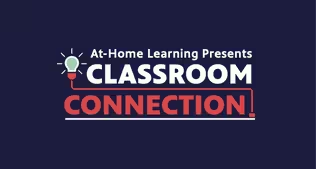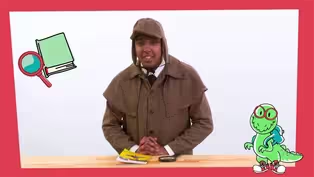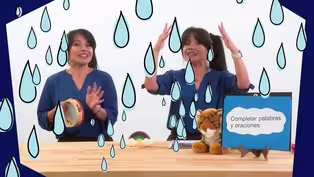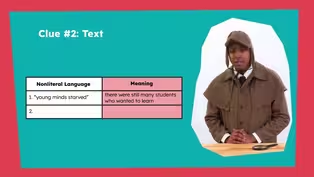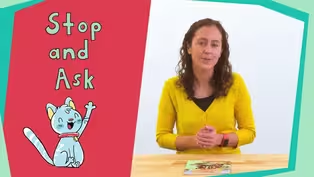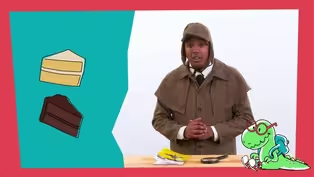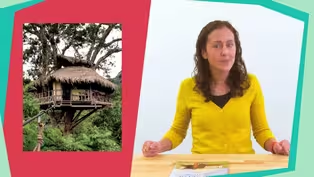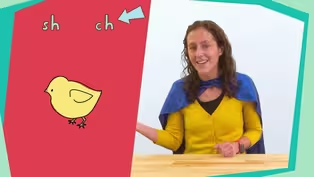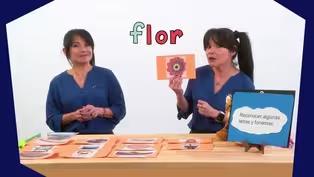
Episode 7 | Literacy Lessons
2/23/2021 | 28m 46sVideo has Closed Captions
Literacy lessons for early learners, led by NC teachers.
The first lesson (aimed at PreK-K learners) helps students recognize letters Pp, Ii, and Gg, and their sounds. The second lesson (aimed at 1st-2nd graders) helps learners understand that when two vowels are together the first one makes the sound. Classroom Connection is your At-Home Learning companion where children love to learn. All lessons are led by NC educators.
Problems playing video? | Closed Captioning Feedback
Problems playing video? | Closed Captioning Feedback
At-Home Learning Presents: Classroom Connection is a local public television program presented by PBS NC

Episode 7 | Literacy Lessons
2/23/2021 | 28m 46sVideo has Closed Captions
The first lesson (aimed at PreK-K learners) helps students recognize letters Pp, Ii, and Gg, and their sounds. The second lesson (aimed at 1st-2nd graders) helps learners understand that when two vowels are together the first one makes the sound. Classroom Connection is your At-Home Learning companion where children love to learn. All lessons are led by NC educators.
Problems playing video? | Closed Captioning Feedback
How to Watch At-Home Learning Presents: Classroom Connection
At-Home Learning Presents: Classroom Connection is available to stream on pbs.org and the free PBS App, available on iPhone, Apple TV, Android TV, Android smartphones, Amazon Fire TV, Amazon Fire Tablet, Roku, Samsung Smart TV, and Vizio.
Providing Support for PBS.org
Learn Moreabout PBS online sponsorshipMore from This Collection
Video has Closed Captions
Literacy lessons for early learners, led by NC teachers. (28m 46s)
Video has Closed Captions
Literacy lessons for early learners, led by NC teachers. (28m 46s)
Video has Closed Captions
Literacy lessons for early learners, led by NC teachers. (28m 45s)
Video has Closed Captions
Literacy lessons for early learners, led by NC teachers. (28m 45s)
Video has Closed Captions
Literacy lessons for early learners, led by NC teachers. (28m 46s)
Video has Closed Captions
Literacy lessons for early learners, led by NC teachers. (28m 46s)
Video has Closed Captions
Literacy lessons for early learners, led by NC teachers. (28m 45s)
Video has Closed Captions
Short Description: Literacy lessons for early learners, led by NC teachers. (28m 45s)
Video has Closed Captions
Literacy lessons for early learners, led by NC teachers. (28m 45s)
Video has Closed Captions
Literacy lessons for early learners, led by NC teachers. (28m 45s)
Video has Closed Captions
Literacy lessons for early learners, led by NC teachers. (28m 45s)
Video has Closed Captions
Literacy lessons for early learners, led by NC teachers. (28m 45s)
Providing Support for PBS.org
Learn Moreabout PBS online sponsorship[cheerful upbeat music] ♪ - Okay, so here's a really cool reading lesson for all you pre-K and kindergartners.
I heard this one is really super duper good.
So you don't want to miss it.
Here we go.
- Hello, super learners.
My name is Mrs. Jennifer, and I'm so excited that you're here.
Well to learn with me today, you will need a piece of paper, a pencil, and a staffed animal for today's lesson.
Ask a trusted adult to help you find these items.
While you're getting your supplies, I'm gonna grab mine as well.
I'll be right back.
[upbeat music] Okay, I'm back now.
And I see you are too.
We have our supplies to let's get started.
Today, we are going to reread "Little Piglets."
We will learn the names of the animals we see.
We will review the parts of a book, reviewed the letters P, I, and G, and spell a word with the letters we have learned.
First, we will be using Elkonin boxes to help us spell a word.
You can make your own Elkonin boxes using a piece of paper, and a pencil.
First, you will fold your paper long wise, like this.
[paper rattling] Then fold in thirds like this.
[paper rattling] Ask a grown-up for help if you need to.
Now you have three Elkonin boxes on top, and three on the bottom of your paper.
Super learners, we have learned three letters together.
Can you tell your staff friend these letters?
Did you say, G, I, and P?
That's right.
We are gonna write those letters in our Elkonin boxes.
We will write one letter in each box across the top of the paper, and then we will spell a word in the bottom boxes.
Now let's write the letter I, in our first box.
We're going to start at the top, make a straight line down.
Then come back to the top, make a straight line from left to right, then we're going go to the bottom and make a straight line from left to right.
Great.
Now let's write the letter P in the middle box.
We're going to start at the top.
We're gonna make a straight line down, then jump back to the top.
And we're going to make a curve line to the right and back to the straight line.
Great job.
Now let's write the letter G in the last box we're gonna start at the top.
We're going to make a curve line down to the left.
Then we're gonna come back up, and slide to the left.
Great.
Great job writing your letters.
Now super learners, I need your help to spell and write the word pig.
Are you ready?
[upbeat music] Great.
First, we need to say the sounds in the word pig.
Hold up one finger for each sound.
Say them to your friend.
[whispers]P, I, G. Let's try it again.
P, I, G. P, I, G. Great.
Now, let's keep your three fingers up.
What was that first sound?
Did you say P?
That's great.
Tell your staff friend which letter spells that sound.
[upbeat music] Did you save P?
That's right.
The letter P is the first letter we need to spell pig.
Let's write it in our first box on the bottom.
We're going to start at the top, make a straight line down.
Then we're gonna jump back to the top and make a curve line to the right and back to the straight line.
Great.
Now P, I, G. Well what was that middle sound we heard in pig?
[upbeat music] Did you say I?
Yes, we heard I.
Tell your friend which letter spells that sound.
[upbeat music] Yes the letter I, is the second letter we need to spell pig.
Let's write it in our second box on the bottom.
Remember we start at the top, make a straight line down.
Then we drop back to the top, make a straight line from left to right then go to the bottom and make another straight line from left to right.
Great job.
P, I, G. Now what was that last sound we heard in the word pig?
Did you say G?
Yes, we heard G. Tell your staff, friend which letter spells that sound.
[upbeat music] Did you say G?
Yes, that's the letter that spells the g sound.
It is the last letter we need to spell our word pig.
Let's write it on our third box on the bottom.
So we're gonna start at the top, we're gonna make a curved line to down and the left, then come up and make us line to the right at the left.
Great.
Wow, super learners, we took the letters we learned and made the word pig.
Can I see your word pig?
[upbeat music] That looks great.
I see you wrote your P, I and G from left to right.
Thanks for helping.
Before we start our story today, I'm gonna talk about some important words for you to know.
Tell your staff friend what I'm holding.
Did you say a baby?
That's right.
A baby is a person who was just born.
Just like people, animals have babies too.
And they have their own names.
[paper rattling] These are ducklings.
Say ducklings with me.
Ducklings.
Ducklings are baby ducks.
Tell your staff friend what we call baby ducks.
Right, ducklings.
[paper rattling] These are chicks.
Say chicks with me.
Chicks.
Chicks are baby chickens.
Tell your friend what we call baby chickens.
Right, chicks.
[upbeat music] These are lambs.
Say lambs with me.
Lambs.
Lambs are baby sheep.
Tell your friend what we call baby sheep.
Right, lambs.
[paper rattling] These are kittens.
Say kittens with me.
Kittens.
Kittens are baby cats.
Tell your friend what we call baby cats.
Right, kittens.
[upbeat music] These are piglets.
Say piglets with me.
Piglets.
Piglets are baby pigs.
Tell your staff friend what we call baby pigs.
Right, piglet.
Now let's get ready to reread our book about Mother Pig and her loss piglets.
While we read, we're gonna listen for the names of the baby animals.
Here is our book.
It is titled "Little Piglets."
A book has several parts.
This part is called the front cover.
It has the title, tells the author and illustrator and shows us a picture about what the story is about.
This is the back cover of the book.
When we open our book, the very first page we come to it's called the title page.
It is called the title page because it has the title on it.
Let's turn our page and look for baby animals while mother pig looks for her lost piglets.
[upbeat music] "Where are my little piglets?"
Says Mother Pig.
"I will look for them."
Mother Pig looks by the pond.
She sees ducklings, but her little pigs are not there.
[paper rattling] Mother Pig looks by the house.
She sees little chicks, but her little piglets are not there.
Mother Pig looks by the gate.
She sees little lambs, but her little piglets are not there.
[paper rattling] Mother Pig looks by the barn.
She sees little kittens, but her little pigs are not there.
Then Mother Pigs sees five little pink tails.
And Mother Pig sees her little piglets.
I'm glad that Mother Pig found her piglets.
Can you tell your staff friend one of the other baby animals that Mother Pig saw while she was looking for her piglets?
[upbeat music] Great thinking.
I remember that Mother Pig saw kittens.
All right super learners.
That's the end of our lesson for today.
Thank you so much for being with me as we reviewed the letters P, I and G. And learned how those letters come together to make a word pig.
I hope you enjoyed hearing the story about Mother Pig and her search for her piglets again, and learning the names for adult and baby animals.
Keep looking for words that begin with the letters, P, I, and G. When you find new P, I, or G words, add them to your circle maps.
I'll see you next time.
- Wow, what a great day so far.
So much great learning going.
Next, we're gonna watch a video about art that I know you'll love.
- Hi, my name is Zach.
And today I'm gonna be showing you a very simple model you can do at home.
All you need for this model is just a sheet of paper.
[upbeat music] So, wait side up which is my green side and I will fold it in half.
[upbeat music] Create sharply, then we're gonna take this corner and fold it up to here now.
It doesn't matter how much you do it, but I like to have a triangle.
But you, do this.
And then take this edge and fold it up to you, like this.
Then we're gonna take these two corners, And we're gonna hold this corner down on this side, and we're gonna turn the model over, and pull this corner down.
[upbeat music] And you've completed the origami cup.
- Hi, my name is Max.
And I have a joke for you.
Why did the man fall into the well?
Because he couldn't see that well.
- [Male Voice] Let's count in Kiswahili.
One.
- [Students] Moja.
- [Male Voice] Moja.
Two.
- [Students] Mbili.
- [Male Voice] Mbili.
Three.
- [Students] Tatu.
- [Male Voice] Tatu.
Four.
- [Students] Nne.
- [Male Voice] Nne.
Five.
- [Students] Tano.
- [Male Voice] Tano.
Six.
- [Students] Sita.
- [Male Voice] Sita.
Seven.
- [Student] Saba.
- [Male Voice] Saba.
Eight.
- [Students] Nane.
- [Male Voice] Nane.
Nine.
- [Students] Tisa.
- [Male Voice] Tisa.
10.
- Kumi.
- [Male Voice] Kumi.
♪ Moja, mbili ♪ ♪ Tatu, nne, tano ♪ ♪ Sita, saba, nane ♪ ♪ Tisa, kumi ♪ ♪ Moja, mbili ♪ ♪ Tatu, nne ,tano ♪ ♪ Sita, saba, nane ♪ ♪ Tisa, kumi ♪ ♪ Moja, mbili ♪ ♪ Tatu, nne, tano ♪ ♪ Sita, saba, nane ♪ ♪ Tisa ♪ - [Boy] Kumi.
- All right, here's a question for you.
Do you have a favorite fruit?
I like strawberries and bananas.
Do you know strawberries are the only fruit to have their seeds on the outside?
I just read that and thought it'd be cool to share.
I love being able to share the things I learned.
Do you?
Let's start our literacy lessons so we can have more knowledge to share hang tight 'cause here it comes.
- Hello readers.
My name is Ms. Gary.
And I'm so excited to be learning with you today.
Before we get started with our lesson, let's hello with our welcome song.
♪ Hello readers ♪ ♪ Hello readers ♪ ♪ How are you ♪ ♪ How are you ♪ ♪ I'm so glad to see you ♪ ♪ I'm so glad to teach you ♪ ♪ Hallow you ♪ ♪ You and you ♪ Friends, do you remember the two types of letter categories there are?
All of the letters in the alphabet can be put into two groups.
Consonants and vowels.
The vowels, a, e i, o, u.
Sometimes y are all of the vowels in our alphabet?
Do you remember the sounds each of our vowels make when we read them in words?
So let's practice saying the vowel sounds together.
We're going to put our arms down to our side for the short vowel sounds.
And we're gonna put our arms up in the air for the long vowel sounds.
Are you ready readers?
There we go.
Short a says a, Long a says a.
Short e says e, and long e says e. The short i says i, the long i says i.
And the short o, o.
And long o, o.
The short u makes the sound u, and the long u makes the sound u.
As a vowel y can make two different sounds.
At the end of a syllable or word, it can make the long e sound, e. Or the long i sound i.
We will find these vowel sounds in every word that we've read and write.
But as a reader, we're always having to use letter sounds to the code and read words.
But sometimes the words that we read, they don't always have letter sounds that match their letters that we see in the word.
So, in addition to knowing all of our long and short bowel sounds during each lesson, we're also going to learn some words.
These words have a special name.
They're called heart words.
We call these words, heart words because we're practicing to read them and remember them by heart.
So that we don't have to sound them out.
To do this today, we're going to create our very own heart word dictionary.
You're going to need two pieces of paper, and something to write with.
I'll go get mine while you grab yours.
[upbeat music] Okay readers, I'm back with my two pieces of paper and something to write with.
I grabbed a marker, but you can use a pencil, crayon or pin.
That's fine too.
To get started with making our heart word dictionary, I'm going to stack my two pieces of paper and then fold them in half, hamburger style, just like this.
[paper rattling] And look at that readers, we have a book.
Now we're gonna make a heart on the front of it, so that we know this is our heart word dictionary.
[soft music] So let's get ready to read our first heart word together.
[soft music] Look at this word.
This is the word other, readers.
Can you say other other?
Good.
Other, let's spell it.
O-T-H-E-R, let's say it.
Now we're going to write the word, other on the first page of our heart word dictionary.
Let's open it up.
And write it out.
O-T-H-E-R. Other.
[soft music] Good job.
Let's get ready for our second heart word, readers.
Can we read this?
This is the word, down.
Can you say, down?
Great.
Let's spell it.
D-O-W-N, down.
Let's say it one more time, down.
Awesome job.
Now let's turn to page two of our heart word dictionary, and write the word, down.
[soft music] D-O-W-N, down.
And that's the second word for our heart word dictionary.
I think that we're ready to add just one more word to our heart word dictionary for today.
Take a look at this word.
This is the word, give.
Can you say, give?
Give.
Now let's spell it.
G-I-V-E, give.
Say it one more time.
Yes, that's right.
Now let's write our third heart word in our heart word dictionary.
Give, G-I-V-E. Give.
Just like that.
Great job.
Now you have a few new heart words that we added to our heart word dictionary.
And later on today, you can share this dictionary with someone that you love and show them all the words that you've learned.
Wow, readers.
You're doing great.
And in today's lesson, we're going to learn about some different vowels called diagraphs.
Diagraphs are when two letters are together but we only hear one sound.
Diagraphs are powerful.
So let's get started with our lesson today.
We reviewed the sounds the vowels make that the a, the e, the i, the o and the u, have long and short sounds.
We also have learned that when two vowels are paired together, they can work as a team.
And the first vowel will say its name.
But let's look at a few vowel diagraphs.
[cat meowing] And what they do, and what pattern they follow.
Today, we're going to practice several diagraphs.
And later on, we'll check our knowledge to complete some sentences.
Are you ready readers?
Let's read this word.
[soft music] Did you say good?
If you said good, great job.
Because this word is good.
So let me break down the sounds that the word good has.
G, oo, d, good.
But let's read this word again.
Good.
The oo is a diagraph that says the sound o.
But that oo diagraph can make another sound.
So let's read this word.
[soft music] Food.
This is the word food.
F, oo, d. Did it make the same sound as in the word good?
No.
Tell me what sound you heard, the oo, in food make.
Good, I heard you say, oo.
So the oo diagraph says the oo sound just like in the word school and spoon.
[soft music] So here's our second diagraph for today.
This diagraph is the ea.
Listen to me read these words.
Head.
Bread.
And spread.
We know that most of the time when two vowels are together, the first vowel says its name.
But listen to me say this word.
[paper rattling] Head.
What sound did we hear it say?
Let's look at the other word that I read.
Bread.
What sound did it say?
E. Instead of making the long e sound, it made the short e sound, e. Bread.
So that vowel diagraph makes the short e sound, e. Now, I want you to take a look at this picture.
What's this a picture of?
[soft music] That's right, it's a reindeer.
Let's listen to the sounds that we hear in reindeer.
I want you to pay close attention to the ei sound in the word reindeer.
R-e-i-n-deer.
Listen to that sound again.
Ei, this vowel diagraph makes the long a sound.
So the ea diagraph like in reindeer makes the long a sound.
[soft music] All right readers, you're ready for our next diagraph?
Going to listen to this words.
[soft music] Cloud.
Sound.
And round.
Let's break the sounds we hear in the word cloud apart.
And I want you to listen to the sounds as I read them.
C-l-oud, cloud.
This, ou, made the ou sound.
So the ou diagraph in words like cloud, and round and sound.
Make the ou sound.
Let's see one more diagraph today.
This diagraph is going to have two different patterns but it's going to say the same sound.
So let's look at the vowel, diagraph aw and au.
Let's read these words.
Draw.
And claw.
Listen to me sound the word draw out.
D-r-aw.
This aw sound, it made the o sound,.
But, listen to another vowel diagraph that has a different spelling but makes the same sound.
Let's read this word.
Pause.
This word is like you pause the TV, if you're watching it.
Pause, p-ause.
So this diagraph au also makes the o sound.
So vowel diagraphs, oo, ea, ei, ou, aw and au, typically will say the long vowel sounds.
But these two vowel diagraphs will say different sounds.
Readers, you did an awesome job today.
Learning about vowel diagraphs, and the special sound that the vowels make when they're together.
So I hope you enjoyed this lesson, and I'll see you again next time.
[upbeat music] - Hi, my name is Wes, and I have a joke for you.
What do you call, feel like cut in the leg.
A drizzly bail.
- For more information about this programming or at home learning initiative, and partner resources, please visit our website at: pbsnc.org/ahl.
[cheerful upbeat music] ♪
Support for PBS provided by:
At-Home Learning Presents: Classroom Connection is a local public television program presented by PBS NC
